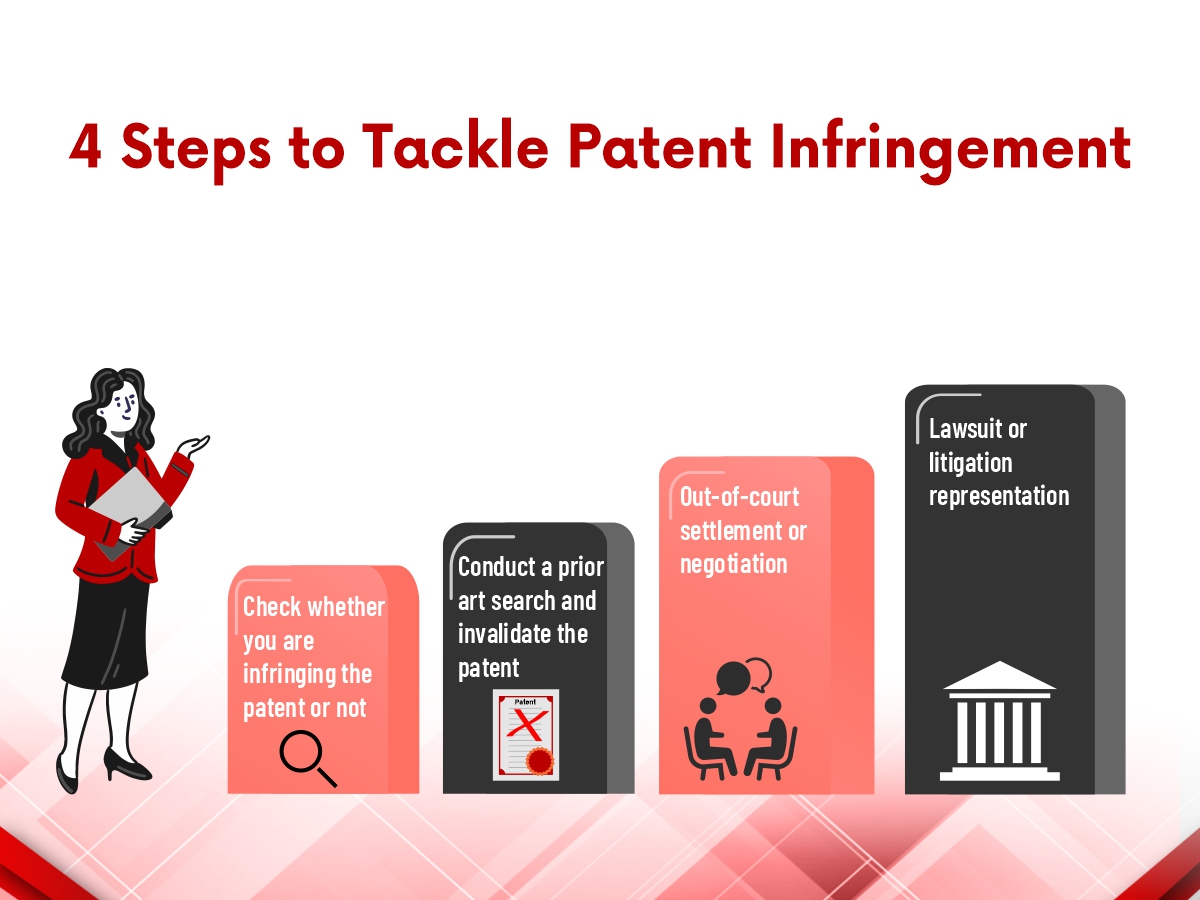Subscribe our newsletter
Please Subscribe our news letter and get update.

Most organisations are busy with their regular business activities and pay little attention to intellectual property challenges that might arise. And then, one day, an accusation of patent infringement arrives. This accusation can be either aggressive official letter asking you to halt production activities or friendly one will be a notice letter mentioning a patent that may be pertinent to your business operations and is open to licensing.
For tackling patent infringement, you must know the steps you need to take after the accusation of patent infringement. This blog will highlight the 4 steps that one should be taken after being accused of patent infringement to maximize an organization`s chances of success going forward when dealing with these circumstances. But let’s first understand,
If you are developing a product or are about to launch one, conducting freedom-to-operate search is the best way to avoid patent infringement. It is the best preventive measure against Patent Infringement. The Freedom to Operate Search (FTO Search) seeks to uncover any active patents that might limit your capacity to operate in a specific jurisdiction. By scanning the patent landscape, you can foresee and reduce the risk of patent infringement and legal action in advance with the help of a freedom-to-operate search (FTO search).
Now that you have to face the patent infringement, these are the steps you can take as remedies against patent infringement:
As your first response to a patent infringement case, you need to evaluate the patent owner’s claim of infringement and determine whether the patent claims cover your product or not. To determine this, you need to check the scope of the claims. If you find out that your product is outside the scope of the patented invention, then you can avoid patent infringement. Knowing the scope of claims will help you know if:
Also, while checking the infringement, keep an eye on the status of the patent to see if it has lapsed or expired due to non-payment of maintenance fees; if that’s the case, there is no infringement. However, if the patent holder revives the lapsed patent by stating that the delay in payment was unintentional, 35 U.S.C. § 41(c)(1), then the patent can be revived and you will be an infringer. That’s why you need to properly check if there is an infringement or not.
In defense to a patent infringement, the next step you can choose to take is to prove the infringing patent invalid. You can prove that the patent granted fails to comply with the patentability criteria.
You can check the file history with the help of IP experts to look for errors or inconsistencies that could render the patent invalid. You can find resources from internal sources, industry sources, and information available from the patent holder. Also, proper claim mapping can be done to invalidate the patent. It will help you establish invalidity based on claims.
Pursuing a patent infringement case is an expensive and time-consuming process. Pursuing lawsuits should be avoided in most cases, as there are more efficient ways to deal with them because infringement lawsuits are costly for both plaintiffs and defendants. One of the alternatives available is an out-of-court settlement. You can invite the other party to have a clear discussion.
You can opt for mediation if you don’t know them and don’t feel comfortable negotiating with them directly. This will allow both parties to benefit from the perspectives of an impartial third-party mediator. By assisting each side in comprehending the other’s perspective, mediators might efficiently encourage a compromise.
If the above-mentioned points are not a way to settle the infringement case, then the last option you have is to proceed with the formal infringement lawsuit.
You need to hire a patent attorney experienced in handling patent infringement cases and familiar with your industry. The plaintiff will file the case in federal court, whereas you as a defendant will have the opportunity to respond, and the case will go on like other civil litigation cases.
If you ignore an infringement allegation after receiving one, you may be responsible for treble damages and legal costs. As per the Patent Act, a reasonable royalty for the infringing product or the patent owner’s lost profits is used to determine damages for patent infringement. Damages could be quadrupled if it is found that the infringement was done deliberately. A court may grant the patent owner’s attorneys’ fees in some circumstances.
A claim of patent infringement is a serious matter that, if ignored, could prove to be an expensive mistake. Early consultation with an experienced patent lawyer can aid in attaining a successful result. It is crucial to respond to the cease-and-desist letter in a knowledgeable manner.
For instance, knowing when to respond to the notice of infringement can aid with response planning and/or settlement negotiations. Your patent attorney can help you find any applicable deadline extensions as well as any potential default deadlines for filing a response.They can also give an overview of the costs and amount of time entailed in each response option.
Being accused of patent infringement is not a pleasant experience, but by following these steps, you can respond to the accusation with confidence and place your company in the best possible position to fight it and continue doing business. Taking such a charge seriously and actively looking into it can save your business from suffering major exposure in the long run.
Authored by – Robin Sharma
Please Subscribe our news letter and get update.
© Copyright 2024 – Wissen Research All Rights Reserved.